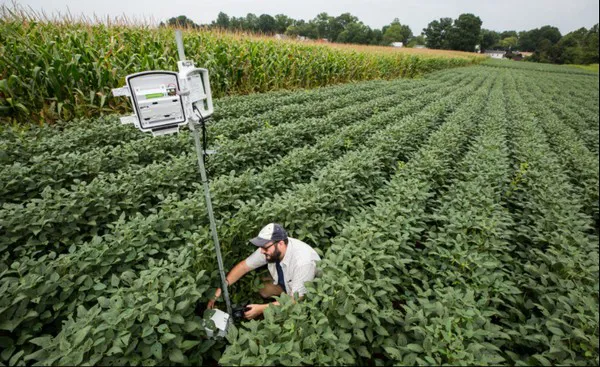Farmers around the world are facing the urgent question of how to sustainably feed a global population expected to reach 9.7 billion by 2050 — and the answer, in part, might be found nestled among the cornstalks and soybeans on a farm a short distance from Washington, D.C. The fields are outfitted with a network of high-tech sensors that could revolutionize how food is grown across the globe by putting data in the hands of farmers and scientists in ways unimaginable a few years ago.

The sensors are part of a groundbreaking new partnership between Microsoft and the U.S. Department of Agriculture (USDA). The 7,000-acre farm at the USDA’s Beltsville Agricultural Research Center in Maryland is using FarmBeats, a project that aims to harness data and artificial intelligence to help farmers cut costs, increase yields and sustainably grow crops that are more resilient to climate change.
“We can’t simply double our acreage to produce this food,” says Dan Roberts, research leader at the Sustainable Agricultural Systems Research Laboratory, located at the Beltsville center. “There’s a lot of competition for arable land with urbanization. What we need to do is develop more environmentally benign crop production systems — the new green revolution, if you will.”
FarmBeats collects data from multiple sources, such as sensors, drones, satellites and tractors and feeds it into cloud-based artificial intelligence models that provide a detailed picture of conditions on the farm. Since most farms have little or no internet access, FarmBeats transmits data via TV white spaces, the unused broadcasting frequencies between television channels, to an edge device at the farm and onto the Microsoft cloud.
The USDA pilot is testing out FarmBeats technology on two crop systems experiments at the Beltsville farm. If all goes as planned, the functionality will be rolled out to 200-plus farms in a nationwide research network, from mom-and-pop operations to large commercial farms. The farmers will be able to see the data generated by FarmBeats in real time; the USDA researchers will use that data to inform their own work and provide web-based tools and site-specific insights to farmers to help them better allocate resources and refine their methods.
The pilot is focused on cover crops, grown during the off-season to limit weeds, manage pests, prevent erosion and improve soil for the main crops. At the Beltsville farm, sensors are measuring soil temperature, humidity and acidity. The sensors also track water levels in the soil, which help determine how much water is retained after increasingly common heavy rainfalls and in turn, inform water budgets for a growing season. A weather station tracks air temperature, precipitation and wind speed, and a tractor with an array of sensors will assess crop heights, biomass and greenness — an indicator of plant health.
Click here to read the full press release.
For more information:
Ranveer Chandra
Microsoft
Tel: +1 425 706 7034
Email: ranveer@microsoft.com
